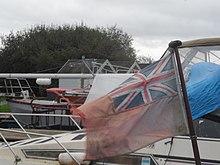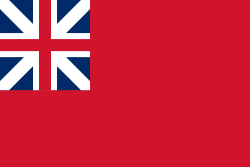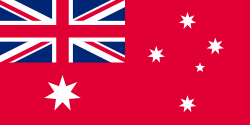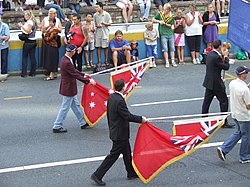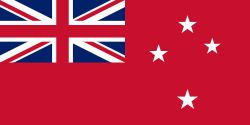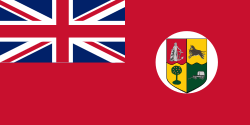
The Union Jack or Union Flag is the de facto national flag of the United Kingdom. The Union Flag was also used as the official flag of several British colonies and dominions before they adopted their own national flags. The flag continues to have official status in Canada, by parliamentary resolution, where it is known as the Royal Union Flag.

The ensign is a maritime flag that is used for the national identification of a ship. The ensign is the largest flag, generally flown at the stern (rear) of the ship while in port. In ports, depending on the ship's origin, it is sometimes identical with a jack on the bow of the ship. Jacks are more common on warships than on merchant ships.

In British maritime law and custom, an ensign is the identifying flag flown to designate a British ship, either military or civilian. Such flags display the United Kingdom Union Flag in the canton, with either a red, white or blue field, dependent on whether the vessel is civilian, naval, or in a special category. These are known as the red, white, and blue ensigns respectively.

The flag of New Zealand, also known as the New Zealand Ensign, is based on the British maritime Blue Ensign – a blue field with the Union Jack in the canton or upper hoist corner – augmented or defaced with four red stars centred within four white stars, representing the Southern Cross constellation.
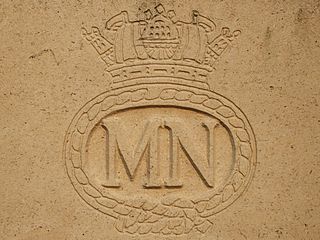
The British Merchant Navy is the collective name given to British civilian ships and their associated crews, including officers and ratings. In the UK, it is simply referred to as the Merchant Navy or MN. Merchant Navy vessels fly the Red Ensign and the ships and crew are regulated by the Maritime and Coastguard Agency (MCA), a specialist agency of the UK Department of Transport. British merchant ships are registered under the UK or Red Ensign group ship registries. British Merchant Navy deck officers and ratings are certificated and trained according to STCW Convention and the syllabus of the Merchant Navy Training Board in maritime colleges and other training institutes around the UK.

The flag of the British Overseas Territory of Bermuda as a red ensign was first adopted on 4 October 1910. It is a British Red Ensign with the Union Flag in the upper left corner, and the coat of arms of Bermuda in the lower right. Prior to this like most of the British colonies at the time it adopted a blue ensign with a seal that depicted a dry dock with three sailing ships. In 1999, the flag was changed to its current form, with an enlarged coat of arms.

The current flag of the Falkland Islands was adopted on 25 January 1999 and consists of a defaced Blue Ensign, with the Union Flag in the canton and the Falkland Islands coat-of-arms in the fly.

The flag of the British Virgin Islands was adopted by Royal Warrant on 15 November 1960 after the islands were made into a separate British colony. Previously, the territory was administered as part of the British Leeward Islands.
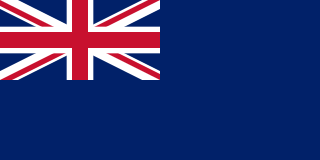
The Blue Ensign is a flag, one of several British ensigns, used by certain organisations or territories associated or formerly associated with the United Kingdom. It is used either plain or defaced with a badge or other emblem.

A maritime flag is a flag designated for use on ships, boats, and other watercraft. Naval flags are considered important at sea and the rules and regulations for the flying of flags are strictly enforced. The flag flown is related to the country of registration: so much so that the word "flag" is often used symbolically as a metonym for "country of registration".

The White Ensign, at one time called the St George's Ensign because of the simultaneous existence of a crossless version of the flag, is an ensign worn on British Royal Navy ships and shore establishments. It consists of a red St George's Cross on a white field, identical to the flag of England except with the Union Flag in the upper canton.
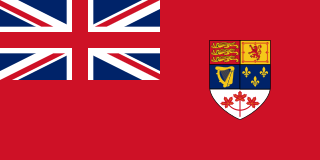
The Canadian Red Ensign served as a nautical flag and civil ensign for Canada from 1892 to 1965, and later as the de facto flag of Canada before 1965. The flag is a British Red Ensign, with the Royal Union Flag in the canton, emblazoned with the shield of the coat of arms of Canada.

The Australian red ensign is the civil ensign of Australia, the flag of nationality flown by Australian registered ships. It is a red version of the national flag, which is mainly blue. Both flags resulted from the Commonwealth Government's 1901 Federal Flag Design Competition which required two entries: an ensign for Commonwealth Government use and another for the merchant navy. The winning design for the merchant ensign was based on the traditional British red ensign and featured the Southern Cross and Commonwealth Star.

The Royal Air Force Ensign is the official flag which is used to represent the Royal Air Force. The ensign has a field of air force blue with the United Kingdom's flag in the canton and the Royal Air Force's roundel in the middle of the fly.
A civil ensign is an ensign used by civilian vessels to denote their nationality. It can be the same or different from the state ensign and the naval ensign. It is also known as the merchant ensign or merchant flag. Some countries have special civil ensigns for yachts, and even for specific yacht clubs, known as yacht ensigns.
The island nation of Malta has a variety of national flags and symbols, some current and some no longer in use.

The Star of India refers to a group of flags used during the period of the British Raj in the Indian subcontinent. India had a range of flags for different purposes during its existence. The Princely states had their own flags which were to be flown alongside the British flag as a symbol of suzerainty. The official state flag for use on land was the Union Flag of the United Kingdom and it was this flag that was lowered on Independence Day in 1947. The flag of the governor-general of India was defaced with the Star of India. The civil ensign and naval ensign were the Red Ensign or Blue Ensign, respectively, defaced with the Star of India emblem.

During the Mandate period in Palestine, between 1920 and 1948, when Palestine was governed by Britain under terms which were formalised in the League of Nations Mandate for Palestine of July 24, 1922, the de facto flag was the Union Jack or Union Flag of the United Kingdom, but several localised flags existed for Mandate government departments and government officials. The only Palestine-specific flag not restricted to official government use was the Palestine ensign, which was flown by ships registered in the British Mandate territory from 1927 to 1948. It was based on the British Red Ensign instead of the Blue Ensign since it was intended for use only at sea by non-government ships.
The Red Ensign Group is a collaboration of United Kingdom shipping registries including British Overseas Territories and Crown dependencies. It takes its name from the Red Ensign flag flown by British civil merchant ships. Its stated purpose is to combine resources to maintain safety and quality across the British fleet. As of 2018 it ranked the ninth largest such group in the world, with approximately 1,300 vessels. Sir Alan Massey of the UK Maritime and Coastguard Agency commented: ".. keeping [ships] inside the REG family means that you still have some influence over their quality and performance... We can take administrative measures against members of [it] if we want to so as to ensure that safety is brought up to the necessary standards..." The vessels also receive British Consular assistance and protection.
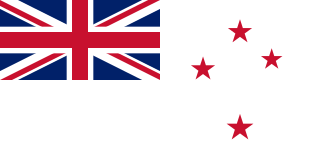
The New Zealand White Ensign is a naval ensign used by ships of the Royal New Zealand Navy (RNZN) from 1968. Based on the Royal Navy's White Ensign, it features the Southern Cross from the New Zealand national flag in place of the Saint George's Cross. One of the earliest flags associated with the country, that used by the United Tribes of New Zealand, was a white ensign. This was replaced by the Union Flag when New Zealand became a British colony. A blue ensign with the Southern Cross was introduced for ships of the colonial government in 1867 and this soon became a de facto national flag. Ships in New Zealand naval service wore the Royal Navy's White Ensign until 1968 when the distinct New Zealand White Ensign was introduced. The ensign was implemented out of a desire to distinguish New Zealand vessels from those of the Royal Navy and this decision is regarded as an important step in the development of the RNZN.


